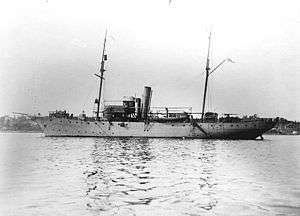HMCS Stadacona
 HMCS Stadacona.
| |
| History | |
|---|---|
| United States | |
| Name: | Columbia |
| Builder: | Crescent Shipyard, Elizabeth |
| Launched: | 1899 |
| Fate: | Acquired by Royal Canadian Navy, 1915 |
| Name: | Stadacona |
| Namesake: | Stadacona |
| Operator: | Royal Canadian Navy |
| Acquired: | 1915 |
| Commissioned: | 13 August 1915 |
| Decommissioned: | 31 March 1920 |
| Renamed: |
|
| Fate: |
|
| General characteristics | |
| Type: | Armed yacht |
| Displacement: | 682 tons |
| Length: | 196.4 ft (59.9 m) |
| Beam: | 33.5 ft (10.2 m) |
| Draught: | 11 ft (3.4 m) |
| Speed: | 12 knots (22 km/h) |
| Complement: | 62 |
| Armament: | 1 x 4 in (102 mm) gun |
HMCS Stadacona was a commissioned patrol boat of the Royal Canadian Navy (RCN) that served in the First World War and postwar until 1920. Stadacona is a historic name associated with Canada, the voyages Jacques Cartier, the colony of Samuel de Champlain, and Quebec City.
Origins
The vessel was built by Crescent Shipyard, Elizabeth, New Jersey as the American steam yacht Columbia, the second yacht of that name built for J. Harvey Ladew of New York, and modeled on the United States Coast Survey steamer Pathfinder that had been built in the same yard.[1][2][3][note 1] Possible conversion into a naval auxiliary was a part of the design with coal fired triple expansion steam engines, capable of a guaranteed 14 knots (16 mph; 26 km/h) allowing for steaming range of 7,000 miles (11,265.4 km) and a sail plan allowing even longer ranges.[1][4]
She was acquired by the RCN in 1915. Prior to the arrival of the French, the location that would become Quebec was the home of a small Iroquois village called "Stadacona", after which the ship is named.[5]
Royal Canadian Navy Service
Stadacona was one of a number of American private yachts acquired by the RCN during the First World War. The date generally given for Stadacona's commissioning is August 1915, although she may have been commissioned as late as March 1916. Largely engaged in patrol duties out of Halifax, Nova Scotia, Stadacona was also Vice-Admiral Sir Charles Kingsmill's flagship. In early 1919, Stadacona, accompanied by a number of Battle-class trawlers, was sent to the west coast via the Panama Canal. She served as a dispatch vessel until being paid off on 31 March 1920, and was then used for fisheries patrol and hydrographic work.
Sale and subsequent career
Sold in 1924, Stadacona became the rum running depot ship Kuyakuzmt before being rebuilt in 1929 as the yacht Lady Stimson. At a later date, she was renamed Moonlight Maid, and in 1941 became a towboat. During World War II Moonlight Maid, a West Coast rum runner during Prohibition before conversion back into a yacht, was acquired by the United States Army and operated as the coastal freighter, U.S. Army FS-539.[6] In 1948, she was burned for salvage at Seattle, Washington.
See also
HMCS Stadacona was also the name of an RCN shore establishment in Halifax, Nova Scotia.
Footnotes
- ↑ There has been confusion between the two yachts. The fist of 1894 was built by Cramp Shipbuilding and later commissioned by the United States Navy in 1898 as USS Wasp—before the second was completed at Crescent. The Dictionary of American Naval Fighting Ships gives an erroneous 1898 build date along with an 11 April 1898 commissioning date for the Cramp Shipbuilding Columbia when contemporary accounts clearly show the second yacht is still being built in 1899. To complicate matters further, the article here uses the commissioning date to distinguish the vessel while the data shows construction starting five years.
References
- 1 2 Marine Engineering (February 1899), p. 21.
- ↑ Colton: Bethlehem Steel Company.
- ↑ Colton: Cramp Shipbuilding.
- ↑ Railroad Gazette (30 June 1899), p. 468.
- ↑ Bumsted, J. M. (2003). Canada's Diverse Peoples: A Reference Sourcebook. Santa Barbara, California: ABC-CLIO. p. 35.
- ↑ Grover 1987, pp. 79, 82.
Bibliography
- Colton, T. (30 September 2014). "Bethlehem Steel Company, Elizabethport NJ". T. Colton. Retrieved 20 March 2015.
- Colton, T. (30 September 2014). "Cramp Shipbuilding, Philadelphia PA". T. Colton. Retrieved 20 March 2015.
- Grover, David (1987). U.S. Army Ships and Watercraft of World War II. Naval Institute Press. ISBN 0-87021-766-6. LCCN 87015514.
- Marine Engineering (1899). "Note". Marine Engineering. New York: Marine Engineering Incorporated. 3 (February 1899): 21. Retrieved 20 March 2015.
- Railroad Gazette (1899). "The Crescent Shipyard". Railroad Gazette. New York. 43 (30 June 1899): 467–468. Retrieved 20 March 2015.
External links
- Converted civilian vessels
- Canadian Navy Heritage Project: Ship Technical Information
- Canadian Navy Heritage Project: Photo Archive
